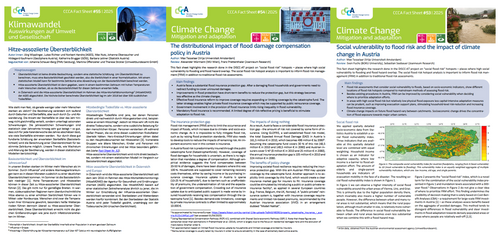Unter den Titeln Hitze-assoziierte Übersterblichkeit, The distributional impact of flood damage compensation policy in Austria und Social vulnerability to flood risk and the impact of climate change in Austria sind drei weitere CCCA-Fact Sheets erschienen!
Fact Sheet Nr. 53: Social vulnerability to flood risk and the impact of climate change in Austria von Max Tesselaar (Vrije Universiteit Amsterdam 2025)
- Flood risk assessments that consider social vulnerability to floods, based on socio-economic indicators, show different locations of flood risk hotspots compared to mainstream methods of assessing flood risk.
- Besides existing procedures in Austria, FRM can be improved by considering social vulnerability when deciding where to prioritize adaptation efforts.
- In areas with high social flood risk but relatively low physical flood exposure less capital-intensive adaptation measures can be prudent, such as improving evacuation support plans, stimulating household-level risk-reduction and increasing flood insurance coverage.
- Climate change impacts on future flood hazard vary between catchments. Socioeconomic change drives the concentration of flood exposure towards major urban centers.
Fact Sheet Nr. 54: The distributional impact of flood damage compensation policy in Austria von Max Tesselaar (Vrije Universiteit Amsterdam 2025)
- Austria faces a substantial flood insurance protection gap. After a damaging flood households and governments need to redirect funding to cover uninsured damages.
- Improvements in flood protection have short-term benefits to reduce the protection gap, but this strategy becomes less effective as the climate changes.
- Effective flood insurance reform to improve coverage requires expanding or limiting coverage by the catastrophe fund. The latter strategy enables higher private flood insurance coverage which may be supported by public reinsurance coverage.
- Government involvement in the provision of flood insurance limits rising inequality in flood vulnerability.
- Mandatory flood insurance is recommended. A limited degree of risk-reflective pricing is beneficial to stimulate adaptation to flood risk.
Fact Sheet Nr. 55: Hitze-assoziierte Übersterblichkeit von Jörg Wipplinger, Lukas Richter, Norbert Handra und Barbara Kovács (AGES), Max Nutz, Johanna Oberzaucher und Hildegard Kaufmann (GeoSphere Austria), Katharina Brugger (GÖG), Barbara Leitner (Statistik Austria)
- Übersterblichkeit ist keine direkte Beobachtung, sondern eine statistische Schätzung. Um Übersterblichkeit zu berechnen, muss eine Basissterblichkeit geschätzt werden, also die Sterblichkeit in einer Normalsituation. Mit einem statistischen Modell kann für bestimmte Zeiträume eine Abweichung von der Basissterblichkeit berechnet werden.
- Hitze-assoziierte Übersterblichkeit ist dann gegeben, wenn in einem bestimmten Zeitraum mit hohen Temperaturen mehr Menschen sterben, als es die Basissterblichkeit für diesen Zeitraum erwarten ließe.
- In Österreich wird die Hitze-assoziierte Übersterblichkeit im Rahmen des Hitze-Mortalitätsmonitorings (HitzeMOMO) der AGES abgeschätzt. Die höchste bisher berechnete Übersterblichkeit lag im Jahr 2018 bei über 500 zusätzlichen Todesfällen.

